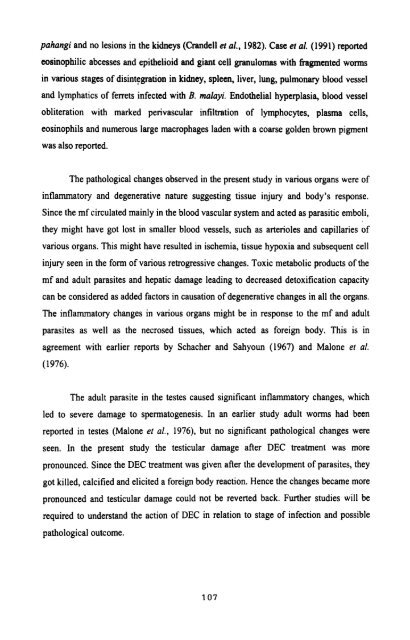effect of infection of the filarial parasite brugia malayi - Pondicherry ...
effect of infection of the filarial parasite brugia malayi - Pondicherry ...
effect of infection of the filarial parasite brugia malayi - Pondicherry ...
You also want an ePaper? Increase the reach of your titles
YUMPU automatically turns print PDFs into web optimized ePapers that Google loves.
pahangi and no lesions in <strong>the</strong> kidneys (Crandell et al., 1982). Case et al. (1991) reported<br />
eosinophilic abcesses and epi<strong>the</strong>lioid and giant cell granulomas with fragmented worms<br />
in various stages <strong>of</strong> disintegration in kidney, spleen, liver, lung, pulmonary blood vessel<br />
and lymphatics <strong>of</strong> ferrets infected with B. <strong>malayi</strong>. Endo<strong>the</strong>lial hyperplasia, blood vessel<br />
obliteration with marked perivascular infiltration <strong>of</strong> lymphocytes, plasma cells,<br />
eosinophils and numerous large macrophages laden with a coarse golden brown pigment<br />
was also reported.<br />
The pathological changes observed in <strong>the</strong> present study in various organs were <strong>of</strong><br />
inflammatory and degenerative nature suggesting tissue injury and body's response.<br />
Since <strong>the</strong> mf circulated mainly in <strong>the</strong> blood vascular system and acted as parasitic emboli,<br />
<strong>the</strong>y might have got lost in smaller blood vessels, such as arterioles and capillaries <strong>of</strong><br />
various organs. This might have resulted in ischemia, tissue hypoxia and subsequent cell<br />
injury seen in <strong>the</strong> form <strong>of</strong> various retrogressive changes. Toxic metabolic products <strong>of</strong> <strong>the</strong><br />
mf and adult <strong>parasite</strong>s and hepatic damage leading to decreased detoxification capacity<br />
can be considered as added factors in causation <strong>of</strong> degenerative changes in all <strong>the</strong> organs.<br />
The inflammatory changes in various organs might be in response to <strong>the</strong> mf and adult<br />
<strong>parasite</strong>s as well as <strong>the</strong> necrosed tissues, which acted as foreign body. This is in<br />
agreement with earlier reports by Schacher and Sahyoun (1967) and Malone el al.<br />
(1976).<br />
The adult <strong>parasite</strong> in <strong>the</strong> testes caused significant inflammatory changes, which<br />
led to severe damage to spermatogenesis. In an earlier study adult worms had been<br />
reported in testes (Malone ef al., 1976), but no significant pathological changes were<br />
seen. In <strong>the</strong> present study <strong>the</strong> testicular damage after DEC treatment was more<br />
pronounced. Since <strong>the</strong> DEC treatment was given after <strong>the</strong> development <strong>of</strong> <strong>parasite</strong>s, <strong>the</strong>y<br />
got killed, calcified and elicited a foreign body reaction. Hence <strong>the</strong> changes became more<br />
pronounced and testicular damage could not be reverted back. Fur<strong>the</strong>r studies will be<br />
required to understand <strong>the</strong> action <strong>of</strong> DEC in relation to stage <strong>of</strong> <strong>infection</strong> and possible<br />
pathological outcome.

















